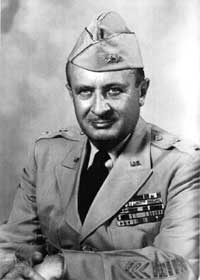US Army General.Led the 37th Infantry Division through the 1944-45 Philippine campiagn. From Ohio Biographies: He served as the Commanding General of the 37th Infantry Division, the only US Army National Guard General to lead his troops through training and into battle during the length of World War II. Born in Marysville, Ohio, his father was an elected local surveyor, city and state engineer and also the president of the Perfect Cigar Company. His mother was a cousin of Commodore. Oliver Hazard Perry, Rhode Island Governor William Sprague IV, and his father, the US Representative and Senator William Sprague III from Rhode Island. As a young boy, he grew vegetables in the back yard and sold them door to door. After graduating from Marysville High School in 1909, he enrolled at Ohio State University (OSU) in Columbus, Ohio for two years. While there he studied civil engineering, trained as a cadet, and was manager of the basketball team. He then left college to work as an assistant engineer with Union County, Ohio. In August 1911 he enlisted with the Ohio National Guard and was part of the 4th Ohio Infantry, which had been re-organized from the 14th Ohio National Guard. He served with Company E, based out of an armory in Marysville and by 1913 he had achieved the rank of first sergeant, and second lieutenant the following year. In August 1916 he was part of the mobilized force that was sent to the Mexican border to pursue the legendary bandit and outlaw, Pancho Villa. In August 1917 he was commissioned as a first lieutenant in the US Army, serving as an adjutant for the 3rd Battalion, 4th Infantry, that would be designated the 166th US Infantry Regiment by the War Department. His unit moved to Camp Mills on Long Island in preparation for deployment to France, in the European theater of World War I. In 1919, after the end of the war, he returned home to Ohio and re-entering civilian life, working as a state engineer in Columbus. He remained in the Ohio National Guard and completed his engineering degree at OSU and started a private civil engineering firm. He attended the Army Command and General Staff School in Leavenworth, Kansas, to complete a course on National Guard Officers, graduating in 1930. In 1932 he returned to active duty, serving with the Army General Staff in Washington DC, exposing him to the highest levels of the Army, something rarely afforded to National Guard officers. He would spend most of his time working on plans for the Interstate Highway System. In 1936 he returned to Ohio, working as chief of staff for the 37th Infantry Division, and commander of the 74th Infantry Brigade. In 1939 he was appointed as the Ohio State Highway Director by Governor John W. Bricker and the following year, he was appointed commanding General of the 37th Infantry Division and immediately began training and preparing his men for war. After the Japanese attack on Pearl Harbor on December 7, 1941, the 37th Infantry Division was mobilized and was sent to the Pacific Theater in 1942. The "Buckeye Division," as they were called, participated in combat victories in battles at New Georgia, Bougainville and Manila, in the Philippines. On September 5, 1945 he accepted the articles of surrender from Major General Iguchi, Commanding General, 80th Brigade, Imperial Japanese Army, in Luzon, Philippines and in November 1945 the 37th was demobilized and returned to the US. In addition to being the US Army's longest serving division commander in 1945, he was appointed to the regular army in 1946 as one of only two National Guard major generals to receive such an appointment at that time. Following the war, he became commander of the 5th Service Command at Fort Hayes in Columbus. In 1947 he was appointed President of the Personnel Board of the Secretary of War in Washington DC. In 1949, he was assigned to the Far East, taking over the Marianas-Bonins Command on the Pacific island of Guam. In 1950 he was appointed the Deputy Military Governor of Okinawa, as well as the Deputy Governor of the Ryukyu Island Command, dedicating most of his time toward rebuilding the infrastructure of the Ryukyu Islands. Following a massive heart attack in 1952, one of nine he would suffer throughout his life, he was flown to Walter Reed Medical Center in Washington DC and he retired from the military in 1953, after 42 years of service. Among his military decorations and awards include the Distinguished Service Cross, the Silver Star, the Purple Heart, the Distinguished Service Medal with 1 oak leaf cluster, the Legion of Merit with one oak leaf cluster, the World War I Victory Medal, the World War II Victory Medal, the Asiatic-Pacific Campaign Medal with 4 service stars, the Combat Infantryman Badge, and the Philippine Legion of Honor. After his military retirement, he headed up the Ohio Turnpike Commission, being appointed its executive director, and oversaw the construction and completion of the Ohio Turnpike. He resigned as executive director to become a member of the commission, before he retired altogether in 1962. In June 1952 he was awarded an honorary doctorate from the University of the Ryukyus for his work in rebuilding the infrastructure. He died in Worthington, Ohio at the age of 85. The National Guard armory in Columbus, Ohio, the headquarters of the Ohio National Guard, is named in his honor. In 1993 the Ohio Department of Veterans Affairs inducted him into the Ohio Veterans Hall of Fame. In 2007 the Ohio Historical Society dedicated an historical marker on 5th Street in Uptown Marysville, Ohio in his honor.

PRIVATE CITIZENS SUPPORTING AMERICA'S HERITAGE
American
War Memorials Overseas, Inc.
War Memorials Overseas, Inc.
Beightler Robert Sprague
Name:
Robert Sprague Beightler
Rank:
Major General
Serial Number:
Unit:
37th Infantry Division
Date of Death:
1978-02-12
State:
Ohio
Cemetery:
Oakdale Cemetery, Marysville, Union County, Ohio
Plot:
Section M
Row:
Grave:
Decoration:
Comments:
